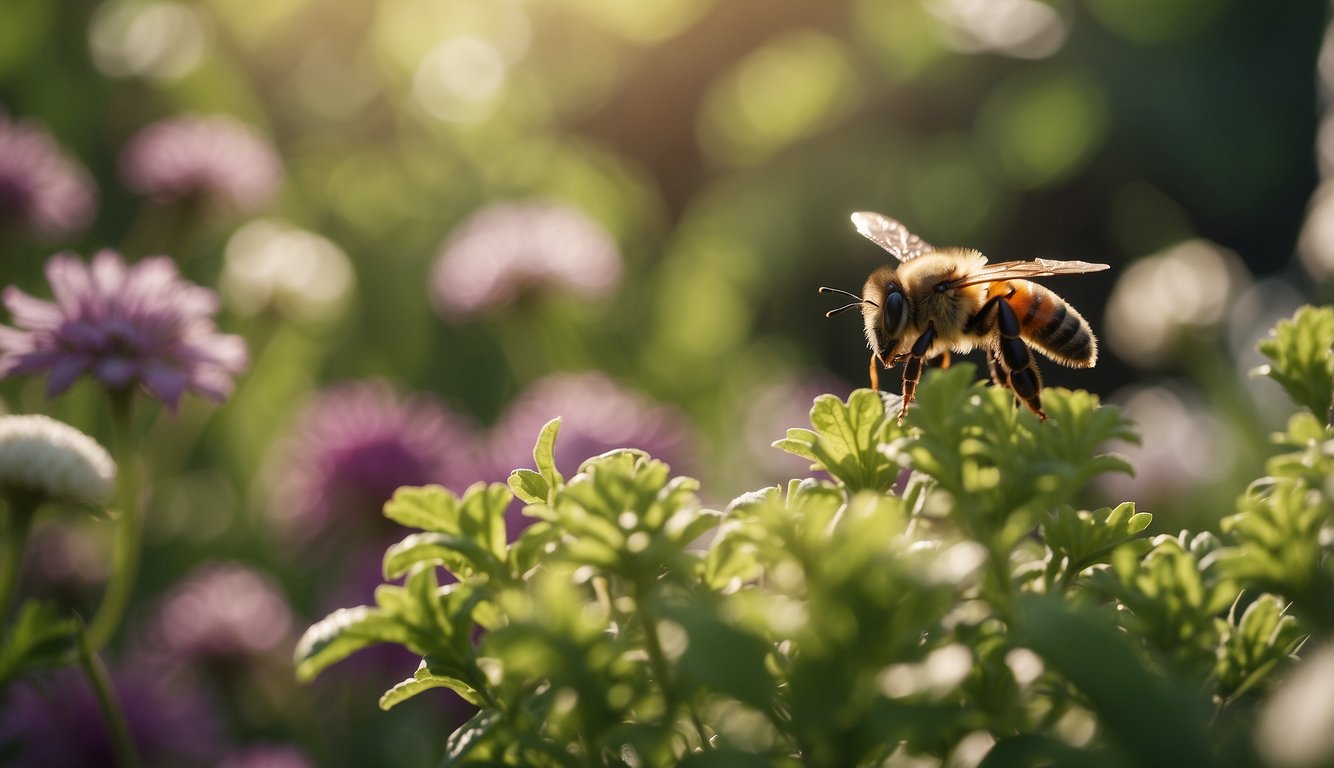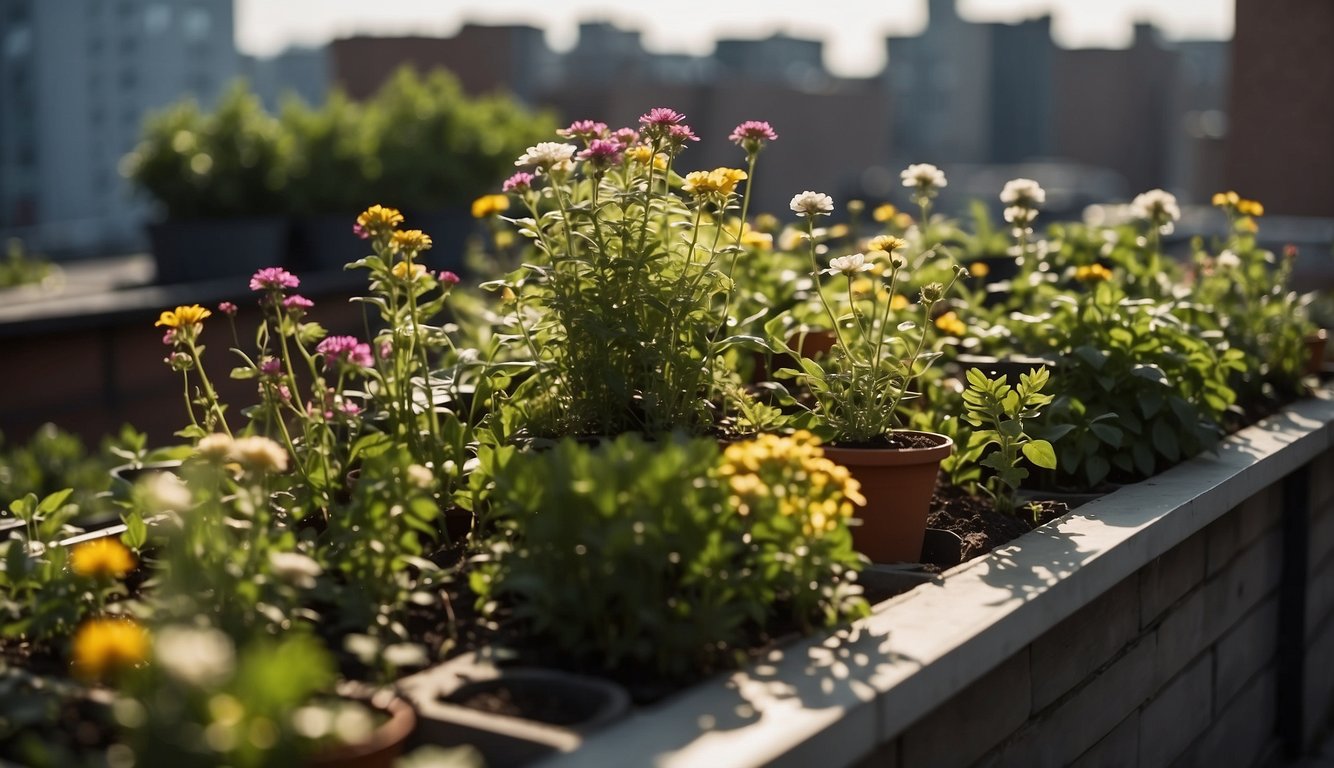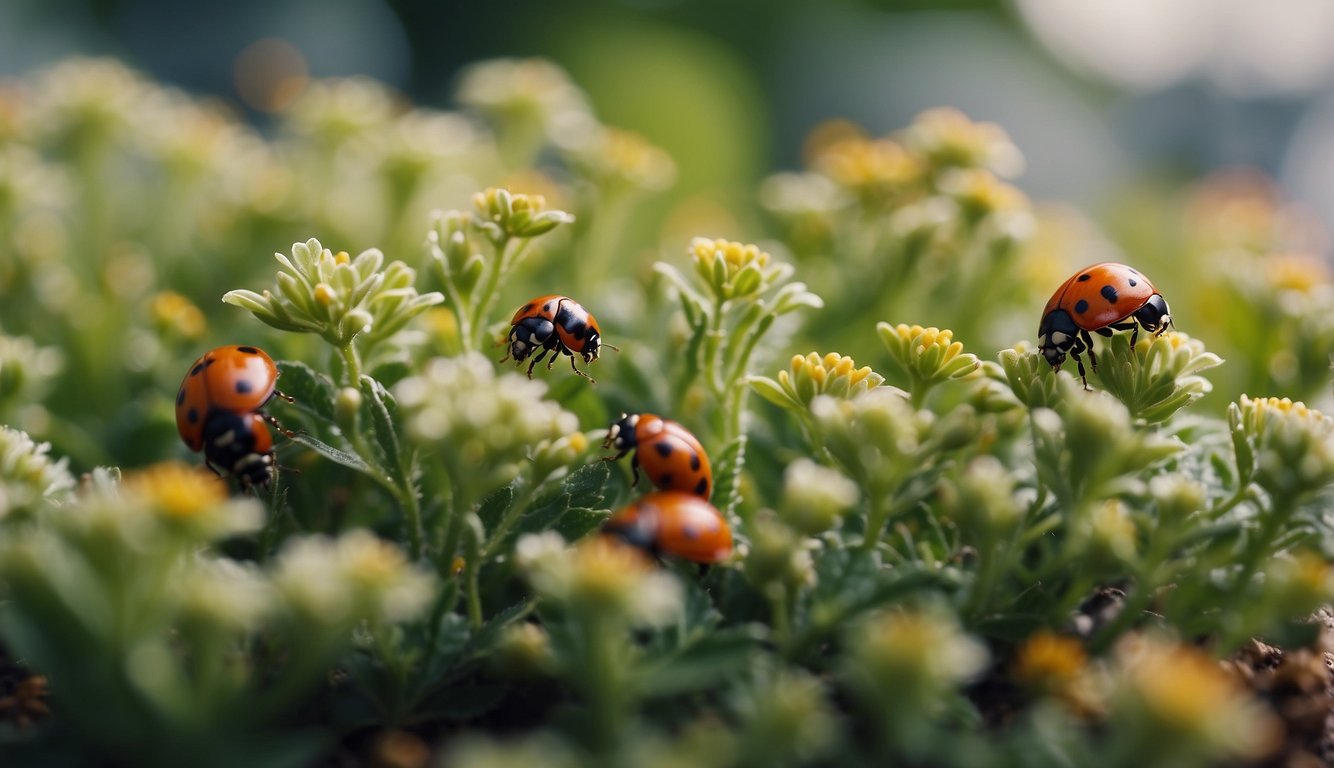Rooftop gardens are gaining popularity as more people seek to grow their own food and connect with nature in urban environments. However, rooftop gardens also face unique challenges, including pest management. Pests such as aphids, spider mites, whiteflies, and caterpillars can quickly damage crops and reduce yields.

Understanding common pests in rooftop gardens and designing a thriving rooftop vegetable garden are key to effective pest control. Organic pest control and prevention strategies, as well as the role of biodiversity and ecosystem health, can also play a crucial role in maintaining a healthy rooftop garden. Practical aspects of rooftop garden maintenance, such as regular monitoring and proper sanitation, are also important for preventing pest infestations.
Table of Contents
Key Takeaways
- Understanding common pests and designing a thriving rooftop garden are key to effective pest management.
- Organic pest control and prevention strategies, as well as the role of biodiversity and ecosystem health, can help maintain a healthy rooftop garden.
- Regular monitoring and proper sanitation are practical aspects of rooftop garden maintenance that can prevent pest infestations.
Understanding Common Pests in Rooftop Gardens

As we start our journey to create a beautiful rooftop garden, it’s essential to understand the common pests that can attack our plants. Early pest detection is crucial to prevent infestations and reduce the risk of reduced yields. Here are some of the most common garden pests that we may encounter in our rooftop gardens:
Aphids: These tiny insects feed on the sap of plants, causing distorted growth and sticky residue on leaves. They can be controlled by spraying the plants with insecticidal soaps or neem oil.
Caterpillars: These larvae of moths and butterflies can cause significant damage to leaves and flowers. Handpicking them off the plants can be an effective control method.
Spider Mites: These tiny pests can cause yellowing and stippling of leaves. They can be controlled by spraying the plants with water or insecticidal soap.
Whiteflies: These small, winged insects suck the sap from plants, causing yellowing and wilting of leaves. They can be controlled by spraying the plants with insecticidal soap or neem oil.
It’s important to note that not all insects are pests. Some insects, such as ladybugs and lacewings, are natural predators that can help control pest populations. Beneficial insects can be attracted to our rooftop gardens by planting flowers such as marigolds and yarrow.
In addition to pests, diseases can also be a problem in rooftop gardens. Disease transmission can occur through contaminated soil, water, or plant debris. To prevent diseases, it’s important to practice proper sanitation and crop rotation. We can also choose disease-resistant plant varieties.
Integrated pest management (IPM) is a holistic approach to pest management that combines biological, cultural, and chemical control methods. Organic pest control methods, such as neem oil and insecticidal soaps, are effective alternatives to synthetic pesticides. Biological control, such as using natural predators, can also be an effective control method.
In conclusion, understanding the common pests and diseases that can affect our rooftop gardens is essential to maintaining a healthy and productive garden. By implementing early pest detection, natural pest control methods, and disease prevention techniques, we can reduce the risk of infestations and enjoy a bountiful harvest.
Designing a Thriving Rooftop Vegetable Garden

When designing a rooftop vegetable garden, we need to consider several factors to ensure a healthy and thriving garden. Here are some key elements to keep in mind:
Spacing and Size
The size of the rooftop garden will depend on the available space and the yield we want to achieve. We need to ensure that there is enough space between plants to allow for proper growth and airflow. Container gardens are a great option for rooftop gardens with limited space.
Sunlight
Most vegetables and herbs require full sun, which means at least six hours of direct sunlight per day. When designing the garden, we need to ensure that the plants receive enough sunlight to grow and produce fresh produce.
Soil Health
Healthy soil is essential for a thriving rooftop vegetable garden. We can improve soil health by adding organic matter, such as compost, and ensuring proper drainage. It’s also important to test the soil regularly to ensure that it has the right pH and nutrient levels.
Biodiversity
A diverse garden is a healthy garden. We can promote biodiversity by planting a variety of fruits, vegetables, and herbs. This not only adds color and interest to the landscape but also attracts pollinators and other beneficial insects.
Pest Management
Preventing pests is key to maintaining a healthy rooftop vegetable garden. We can use physical barriers, such as netting, to keep pests out. Choosing pest-resistant varieties and practicing proper sanitation can also help reduce the risk of infestations.
Cost
Designing a rooftop vegetable garden can be expensive, but it doesn’t have to be. We can save money by using gardening tools we already have and by starting with a small garden and expanding over time. Container gardens are also a cost-effective option for rooftop gardens with limited space.
Environmentally Friendly
Rooftop vegetable gardens are environmentally friendly because they provide green space in urban areas and promote sustainable living. We can further reduce our environmental impact by using organic gardening practices and choosing plants that are native to the area.
Organic Pest Control and Prevention Strategies
When it comes to managing pests in our rooftop garden, we always prefer organic methods to harmful chemicals. Not only do they safeguard us against the harmful effects of pesticides, but they also have environmental benefits. In this section, we will discuss some of the best organic pest control and prevention strategies that we can implement in our rooftop garden.
Implementing Preventive Measures
Prevention is better than cure, and this holds true for pest management in our rooftop garden as well. By implementing physical barriers, we can prevent pests from entering our garden. We can also use companion planting techniques to deter pests. For instance, planting lavender near our vegetables can help repel thrips, a common pest that damages our plants. Additionally, we can use cover crops to improve soil health and prevent weeds from growing, which can harbor pests.
Natural Pest Control Methods
We can also use natural predators to control pests in our garden. For instance, ladybugs can feed on aphids, while praying mantises can feed on slugs and snails. We can also introduce beneficial insects like nematodes and parasitic wasps to control pests. Other natural pest control methods include homemade organic repellents, such as garlic spray, and using organic pesticides like neem oil.
To ensure the effectiveness of our pest control measures, we need to practice early pest detection. Regularly inspecting our plants can help us spot any signs of pest damage or fungal diseases. We should also maintain proper humidity levels and ensure good air circulation to prevent fungal diseases. Proper drainage and fertilization can also help strengthen our plants and make them less susceptible to pest damage.
In conclusion, organic pest control and prevention strategies are the best way to manage pests in our rooftop garden. By implementing physical barriers, using natural predators, and practicing early pest detection, we can safeguard our plants against pests and fungal diseases. We should also use organic pesticides and repellents when necessary, and ensure proper irrigation and fertilization to keep our plants healthy and strong.
The Role of Biodiversity and Ecosystem Health

As we manage pests in our rooftop garden, it’s important to consider the role of biodiversity and ecosystem health. Biodiversity refers to the variety of living organisms in an ecosystem. By promoting biodiversity in our garden, we can create a more resilient and sustainable system that is better able to resist pest outbreaks.
One way to promote biodiversity is by encouraging natural predators and beneficial insects in the garden. Ladybugs, lacewings, and parasitic wasps are just a few examples of insects that can help control pest populations. By providing habitat and food sources for these insects, we can create a more balanced ecosystem that is less reliant on pesticides.
Another important aspect of biodiversity is pollinators. Bees, butterflies, and other pollinators are essential for many plants to produce fruits and seeds. By planting a variety of flowers and herbs, we can attract and support these important insects.
In addition to promoting biodiversity, a healthy rooftop garden can provide a range of environmental benefits. For example, rooftop gardens can help mitigate the urban heat island effect by reducing the amount of heat absorbed by buildings and pavement. They can also improve air quality by absorbing pollutants and releasing oxygen.
Companion planting and cover crops are two additional strategies that can help promote biodiversity and ecosystem health. Companion planting involves planting different crops together that provide mutual benefits, such as repelling pests or improving soil health. Cover crops are planted during fallow periods to protect and improve the soil.
Overall, by promoting biodiversity and ecosystem health in our rooftop garden, we can create a more sustainable and resilient system that is better able to resist pest outbreaks and provide a range of environmental benefits.
Practical Aspects of Rooftop Garden Maintenance

Maintaining a rooftop garden can be a rewarding experience, but it does require some effort and attention to detail. In this section, we will discuss some practical aspects of rooftop garden maintenance, including watering and irrigation, soil health and fertilization, and pest and disease monitoring.
Watering and Irrigation
Watering is one of the most important aspects of rooftop garden maintenance. Rooftop gardens tend to dry out quickly, so it is important to water them regularly. The amount of water required will depend on the size of your garden, the type of plants you are growing, and the weather conditions in your area.
One way to ensure that your plants get enough water is to install an irrigation system. This can be as simple as a hose with a sprinkler attachment, or as complex as a drip irrigation system. An irrigation system can help you save time and water, while also ensuring that your plants get the right amount of moisture.
Soil Health and Fertilization
Soil health is another important aspect of rooftop garden maintenance. The soil in your garden should be rich in nutrients and organic matter. You can improve the health of your soil by adding compost or other organic matter on a regular basis.
Fertilization is also important for the health of your plants. You can use commercial fertilizers or make your own using compost or other organic materials. It is important to follow the instructions carefully when using fertilizers, as over-fertilization can be harmful to your plants.
Pest and Disease Monitoring
Pest and disease monitoring is essential for the health of your rooftop garden. Early detection is key to preventing infestations and diseases from spreading. You should inspect your plants regularly for signs of pests or diseases, such as yellowing leaves, wilting, or spots on the leaves.
There are many natural or organic pest control methods that you can use to protect your garden while maintaining a healthy ecosystem. For example, you can use companion planting, which involves planting certain plants together to deter pests. You can also use physical barriers, such as netting or row covers, to keep pests away from your plants.
In conclusion, maintaining a rooftop garden requires attention to detail and some effort, but it can be a rewarding experience. By following these practical tips for watering and irrigation, soil health and fertilization, and pest and disease monitoring, you can help ensure the health and productivity of your rooftop garden.
Conclusion
In this article, we have discussed various methods of pest management for rooftop gardens. By implementing proper pest and disease management techniques in your rooftop vegetable garden, you can ensure the health and productivity of your plants.
We have learned that organic solutions for pest and disease management in a rooftop vegetable garden include using neem oil, introducing beneficial insects, and practicing proper sanitation. These natural methods are effective and environmentally-friendly solutions for dealing with pests and diseases in rooftop gardens.
It is also important to note that prevention is key in pest management. Regularly inspecting plants for early signs of infestation and implementing preventative measures such as companion planting can help to minimize the risk of pests and diseases.
In addition, adapting your care routine with the seasons ensures your rooftop garden remains vibrant year-round. For example, in spring, prepare your garden for new plantings by refreshing the soil and cleaning out containers. Summer demands diligent watering and pest management. Come fall, consider adding organic mulch to protect plants from cooler temperatures.
Overall, with proper pest management techniques and regular care, your rooftop garden can thrive and provide you with fresh, healthy produce.
Frequently Asked Questions
What are the most common pests found in rooftop gardens?
Pests that are commonly found in rooftop gardens include aphids, spider mites, whiteflies, thrips, caterpillars, and slugs. These pests can cause damage to the plants and reduce the yield of your garden.
How can I prevent pest infestations in my rooftop garden?
Prevention is key in managing pests in your rooftop garden. You can prevent pest infestations by implementing physical barriers, choosing pest-resistant varieties, practicing proper sanitation, and using companion planting techniques. Regularly inspecting your plants for signs of pests and promptly removing any infested plants can also help prevent the spread of pests.
What natural pest control methods are effective for rooftop gardens?
There are several natural pest control methods that are effective for rooftop gardens. These include introducing beneficial insects such as ladybugs and lacewings, using insecticidal soaps and oils, and using neem oil. You can also use homemade remedies such as garlic and pepper spray or beer traps to control pests.
How do I safely remove pests from my rooftop garden without harming the plants?
When removing pests from your rooftop garden, it is important to do so safely without harming the plants. You can remove pests by handpicking them off the plants, using a strong stream of water to wash them off, or using a vacuum cleaner to suck them up. You can also use sticky traps or pheromone traps to capture pests.
Can companion planting help control pests in rooftop gardens?
Companion planting can be an effective way to control pests in rooftop gardens. Certain plants can repel pests while others can attract beneficial insects that prey on pests. For example, planting marigolds can help repel aphids, and planting dill can attract ladybugs which prey on aphids and other pests.
What are the signs of pest damage to look out for in a rooftop garden?
Signs of pest damage in a rooftop garden can include wilting leaves, yellowing leaves, holes in leaves, distorted growth, and stunted growth. You may also see pests themselves or their waste products on the plants. Regularly inspecting your plants for signs of pests can help you identify and address pest problems before they become severe.



